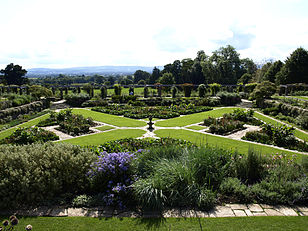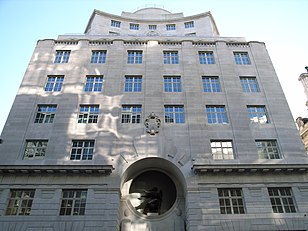
Edwin Lutyens
Sir Edwin Landseer Lutyens OM KCIE PRA FRIBA (/ˈlʌtjənz/ LUT-yənz; 29 March 1869 – 1 January 1944[2]) was an English architect known for imaginatively adapting traditional architectural styles to the requirements of his era. He designed many English country houses, war memorials and public buildings. In his biography, the writer Christopher Hussey wrote, "In his lifetime (Lutyens) was widely held to be our greatest architect since Wren if not, as many maintained, his superior".[3] The architectural historian Gavin Stamp described him as "surely the greatest British architect of the twentieth (or of any other) century".[4]
"Lutyens" redirects here. For other uses, see Lutyens (disambiguation).
Edwin Lutyens
1 January 1944 (aged 74)
Architect
- Charles Augustus Henry Lutyens
- Mary Theresa Gallwey
Lutyens played an instrumental role in the construction of New Delhi, which would later on serve as the seat of the Government of India.[5] In recognition of his contribution, New Delhi is also known as "Lutyens' Delhi". In collaboration with Sir Herbert Baker, he was also the main architect of several monuments in New Delhi such as the India Gate; he also designed the Viceroy's House, which is now known as the Rashtrapati Bhavan. Many of his works were inspired by Indian architecture.[6][7] He was elected Master of the Art Workers' Guild in 1933.[8][9]
Early life[edit]
Lutyens was born in Kensington, London,[10] the tenth of thirteen children of Mary Theresa Gallwey (1832/33–1906) from Killarney, Ireland, and Captain Charles Augustus Henry Lutyens (1829–1915), a soldier and painter.[11][12] His sister, Mary Constance Elphinstone Lutyens (1868–1951), wrote novels under her married name of Mrs George Wemyss.[13] He grew up in Thursley, Surrey. He was named after a friend of his father, the painter and sculptor Edwin Henry Landseer. Lutyens studied architecture at South Kensington School of Art, London, from 1885 to 1887. After college he joined the Ernest George and Harold Peto architectural practice. It was here that he first met Sir Herbert Baker. For many years he worked from offices at 29 Bloomsbury Square, London.
Lutyens married Lady Emily Bulwer-Lytton (1874–1964) on 4 August 1897 at Knebworth, Hertfordshire. She was third daughter of Edith (née Villiers) and the 1st Earl of Lytton, a former Viceroy of India. Lady Emily had proposed to Lutyens two years before the wedding, and her parents disapproved of the marriage.[40] Their marriage was largely unsatisfactory, practically from the start, with Lady Emily developing interests in theosophy, Eastern religions, and being drawn both emotionally and philosophically to Jiddu Krishnamurti.[41] They had five children:
During the later years of his life, Lutyens suffered with several bouts of pneumonia.
Death[edit]
In the early 1940s he was diagnosed with cancer. He died on 1 January 1944 and was cremated at Golders Green Crematorium in north London where he had designed the Philipson Mausoleum in 1914–1916. His ashes were interred in the crypt of St. Paul's Cathedral, beneath a memorial designed by his friend and fellow architect William Curtis Green.




![Daneshill Brick and Tile Company offices, near Old Basing, Hampshire (1903)[52]](http://upload.wikimedia.org/wikipedia/commons/thumb/b/bf/Lutoffice8Jl6-3786.jpg/348px-Lutoffice8Jl6-3786.jpg)
![Country Life Offices, Tavistock Street, London (1905)[53]](http://upload.wikimedia.org/wikipedia/commons/thumb/b/b9/Country_Life_Offices_London.jpg/265px-Country_Life_Offices_London.jpg)





![British Medical Association, Tavistock Square, London (1911)[46]](http://upload.wikimedia.org/wikipedia/commons/thumb/b/bb/BMA_House.JPG/308px-BMA_House.JPG)








![Midland Bank Headquarters, Poultry, London (1924)[54]](http://upload.wikimedia.org/wikipedia/commons/thumb/b/bb/Lutyens_Midland_Bank.JPG/345px-Lutyens_Midland_Bank.JPG)







![67–68 Pall Mall, London (1928)[55]](http://upload.wikimedia.org/wikipedia/commons/thumb/3/3a/67-68_Pall_Mall.jpg/251px-67-68_Pall_Mall.jpg)





![Architectural model of unrealised design for Liverpool Metropolitan Cathedral (1933)[56]](http://upload.wikimedia.org/wikipedia/commons/thumb/f/fc/LPoolLutyens-wyrdlight-802726.jpg/308px-LPoolLutyens-wyrdlight-802726.jpg)


![Broughton memorial lodge, Runnymede, Surrey (1930–1932)[57]](http://upload.wikimedia.org/wikipedia/commons/thumb/9/95/LodgeRunnymede.jpg/347px-LodgeRunnymede.jpg)




![Runnymede Bridge, Surrey (opened 1961)[58]](http://upload.wikimedia.org/wikipedia/commons/thumb/3/38/Runnymede_Bridge_%28upstream%29.JPG/371px-Runnymede_Bridge_%28upstream%29.JPG)
